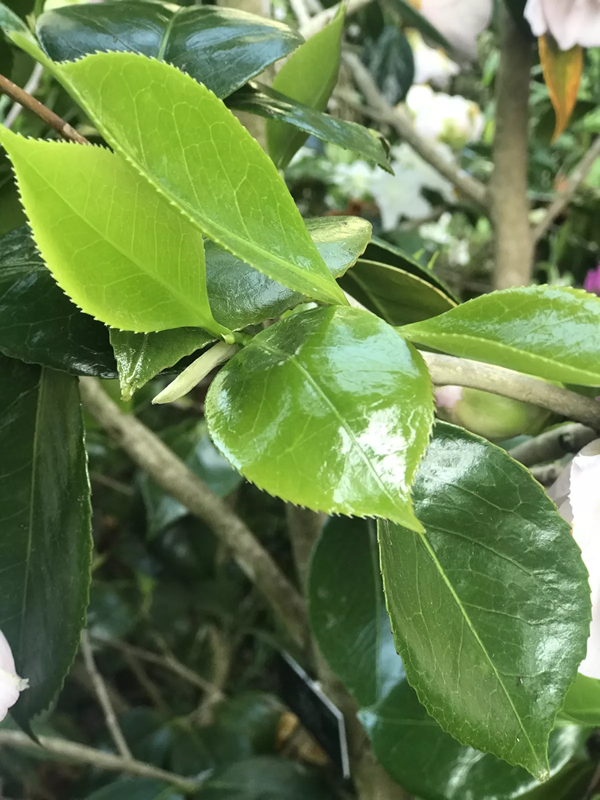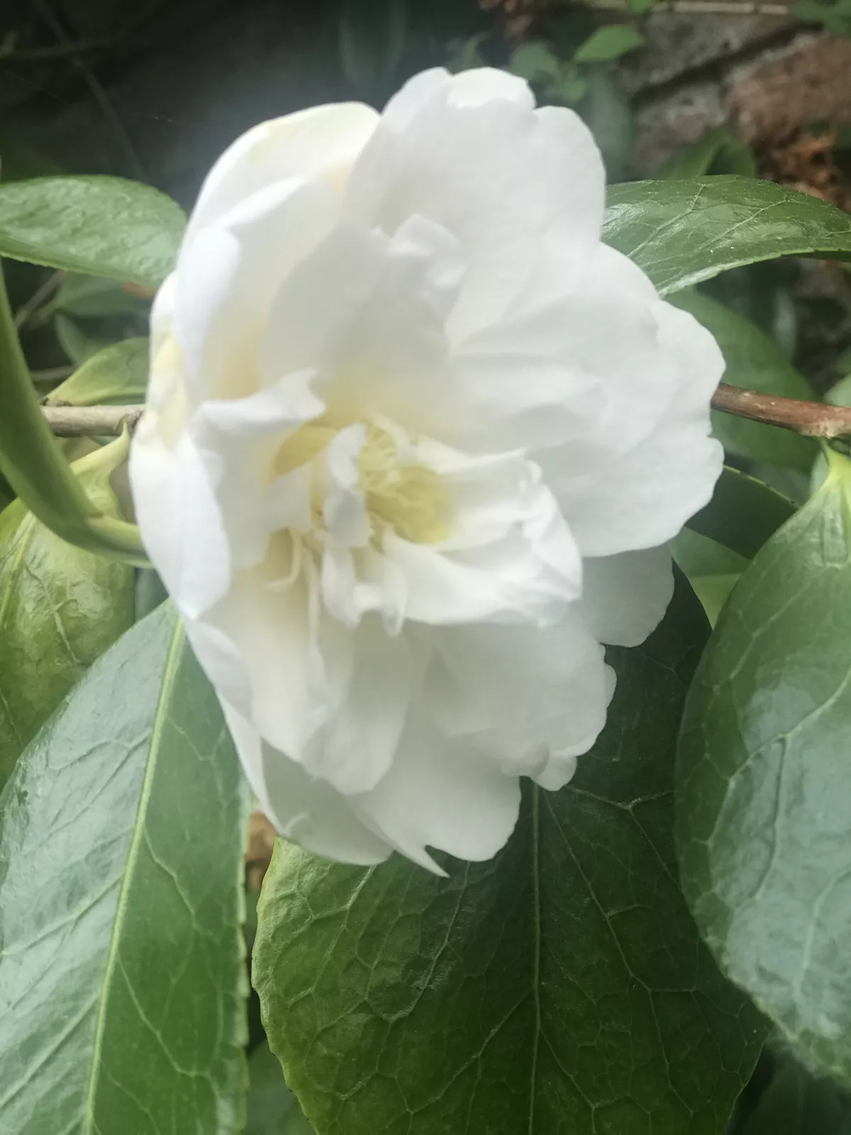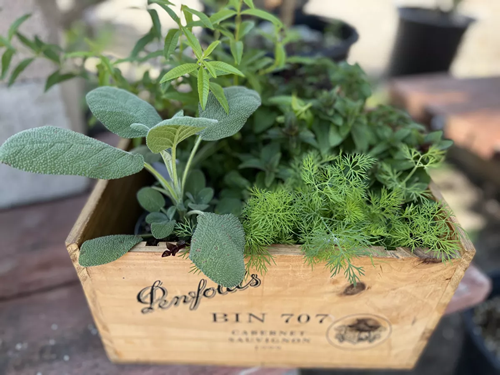Tea, the world’s most beloved drink, could start as shrub in your own yard

Camellia sinensis. All teas (except herbal) come from this plant.(Barb Sands)
San Diegans in the right zones can grow their own Camellia sinensis
By BARB SANDS
(This article was originally published in the San Diego Union-Tribune on January 14, 2023)
It may come as a surprise, but yes, you can grow and make your own tea right here in San Diego County’s backyards and balconies.
Traditional tea is harvested from the evergreen shrub Camellia sinensis, the tea plant. However, as we know it today, tea comes from the Camellia sinensis shrub or from fruit infusions, flowers and roots.
The story of tea begins in China, approximately 2737 B.C. According to legend, the Chinese emperor Shen Nung was sitting beneath a Camellia sinensis tree, waiting for his servant to boil water to purify it. Leaves from the tree blew into the water, when Shen Nung — also a renowned herbalist — decided to try the infusion that his servant had accidentally created. It both stimulated the emperor and was said to detoxify. It wasn’t until the Han dynasty (206 B.C. to A.D. 220), however, that tea became a true beverage.
Camellias were cultivated in the gardens of China and Japan for centuries before they were seen in Europe and the West. During the first Opium War (1839-1942), Britain’s tea supply was threatened. The British transported tea plants from China to India in portable glasshouses sown with tea seeds that subsequently germinated en route to India (Assam).

In addition to using the leaves for tea, the Camellia sinensis plant has beautiful white flowers.(Barb Sands)
The camellia arrived in America in 1797 from England, when Col. John Stevens brought the plant and flower as part of an effort to add to attractions within Elysian Fields, a recreational park in Hoboken, N.J. Meanwhile, new varieties of tea, imported through the British East India Co., flourished in the U.K. with the expansion of the commercial tea trade in the late 1800s. By 1819, at least 25 camellias had bloomed in England. After Britain introduced tea to Ceylon (a former colony, now Sri Lanka), Britain became the world’s No. 1 producer of tea. Tea has been the national drink in Britain for over 200 years.
True tea is made from the leaves of the Camellia sinensis, an evergreen shrub. Green, black, white and oolong all come from this plant. C. sinensis var. sinensis is most often used to make white, green and oolong teas. Camellia sinensis leaves are smaller, and the shrub prefers cooler climates and higher elevations. C. sinensis var. assamica is large-leafed and prefers subtropical climates, warmth and humidity.
Camellia sinensis produces tiny white flowers, prefers a well-drained, sandy soil location and loves sun. Camellia scale, or tea scale, is its pest. Camellia scale is generally seen under the leaves and can be controlled, if detected early, by the use of insecticidal soap, good plant air circulation and proper pruning. You may also consider using environmentally friendly oil.
It is possible to grow tea in the United States, but only in hardiness zones 7 through 9. San Diego County lies in the USDA Plant Hardiness Zones 8, 9 and 10. Plant Camellia sinensis in the spring or fall from seeds, rooted cuttings or sourcing plants from a nursery. It is a large shrub and will produce small, white flowers between October and December, preferring shade. Acidic soil with a pH of 6.5 or lower is preferred. Prune only after the plant has flowered. You will need patience, as it may take three years before you can harvest the young shoots or tips of just two to three leaves.
Once the plant is harvested, processing the leaves determines whether it will be a black, green, white or oolong tea. White tea is made by using only the unopened leaf buds. Light green and the tenderest leaves are used to make green tea (with only slight processing). Oolong is made by oxidizing young leaf tips through roasting and rolling. Finally, black tea is produced from the leaves of the Camellia sinensis var. assamica plant and the leaves are oxidized to bring out the rich and bold taste of black tea.
Teas using herbs, flowers, bark, roots and fruits are called tisanes, a French word for herbal infusion. Don’t be fooled: Teas brewed from the Camellia sinensis leaves contain caffeine (more of a stimulant than an excitant like coffee), whereas tisanes are caffeine-free.

Herb tea sampler. Gardeners can grow their own plants for herbal teas similar to this one.(Barb Sands)
Numerous leaves from various herbs and flowers can be used to make your own cup of home-brewed tea. Use sage, holy basil, lemon verbena, lavender mint or flowers from chamomile, dandelion, jasmine or calendula.
You can grow all of these in containers, too. The best places to store teas are in a glass jar or any dry tin with lid. Plant, harvest your herbs and dry them (baking sheet in the oven for a few days without heat) and remove for storage or gift giving. Most of our harvesting here in San Diego will begin in April to September for you to dry your leaves.
Although Americans are not top cultivators of this famous evergreen shrub, 80 percent of us are tea drinkers — primarily iced or plain black. Go ahead and make your own tea: Plant an immune-boosting, stomach-calming, or sleep-time garden right here in San Diego County and reap the many benefits of tea.
Sands, a UCCE Master Gardener of San Diego County since 2014, is an avid tea drinker and her hobbies include growing herbs and flowers in containers to make her own teas.

